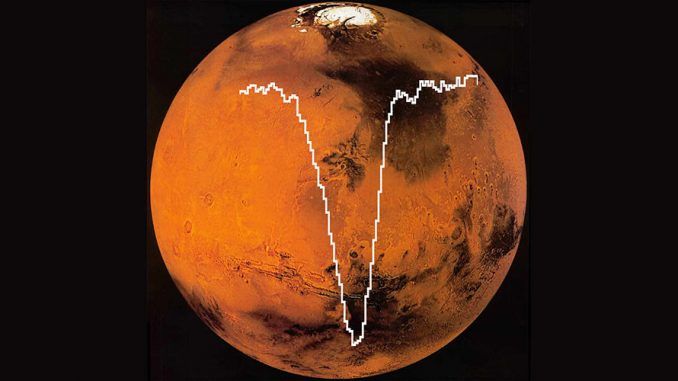
NASA researchers have detected atomic oxygen in Mars’ upper atmosphere for the first time in forty years.
NASA’s airborne observatory SOFIA (Stratospheric Observatory for Infrared Astronomy) has detected single molecules of oxygen in the Martian atmosphere.
The observatory is mounted on a specially-equipped 747 that soars high above the earth (45,000 feet) and has a clearer view of the heavens than telescopes on earth.
 Science Alert reports:
Science Alert reports:

BYPASS THE CENSORS
Sign up to get unfiltered news delivered straight to your inbox.
You can unsubscribe any time. By subscribing you agree to our Terms of Use
The oxgyen atoms were found in the Martian upper atmosphere – known as the mesosphere – and the discovery could help astronomers identify how gases escaped from the Red Planet long ago. While this is super exciting for our understanding of Mars – humanity’s potential new home – the researchers found only half the amount of oxygen they expected, but this could be the result of variations in the atmosphere.
The last time atomic oxygen was observed in the Martian atmosphere was during the Viking and Mariner missions of the 1970s. So why such a long gap? Well, there’s really one thing to blame: Earth’s blue skies.
“Atomic oxygen in the Martian atmosphere is notoriously difficult to measure,” said SOFIA project scientist, Pamela Marcum. “To observe the far-infrared wavelengths needed to detect atomic oxygen, researchers must be above the majority of Earth’s atmosphere and use highly sensitive instruments, in this case a spectrometer. SOFIA provides both capabilities.”
Yup, researchers have been at war with Earth’s skies for decades now, because it’s dense and moist enough to make it extremely difficult to accurately see the Universe lying beyond it. So, to overcome this problem, researchers have implemented a bunch of workarounds (like making fake stars with giant lasers), which is where SOFIA comes in.
For the uninitiated, SOFIA is basically a giant aeroplane – a Boeing 747SP jetliner – with a large, 254-cm (100-inch) diameter telescope on it that can soar above most of Earth’s atmosphere to provide a clear picture.
Having such a high vantage point, in addition to specialised equipment that’s designed to ignore Earth’s atmosphere, enabled the team to make their calculations.
While the team hasn’t given any exact figures on just how much atomic oxygen is in the Martian mesosphere, they do state that it was lower than expected. Because of this, the team will continue to use SOFIA to gauge other areas of the planet to ensure this figure isn’t the result of simple variations in the atmosphere.
In other words, it looks like we have to wait for the full results. In the meantime, get excited about the highly speculative possibility of terraforming the Red Planet:
Edmondo Burr
CEO
Assistant Editor
Latest posts by Edmondo Burr (see all)
- Police Arrest Suspect In Supermarket Baby Food Poisoning - October 1, 2017
- Seoul Secures Data From Electromagnetic Interference By N Korea - September 30, 2017
- The ‘World’s First Internet War’ Has Begun: Julian Assange - September 30, 2017


Be the first to comment